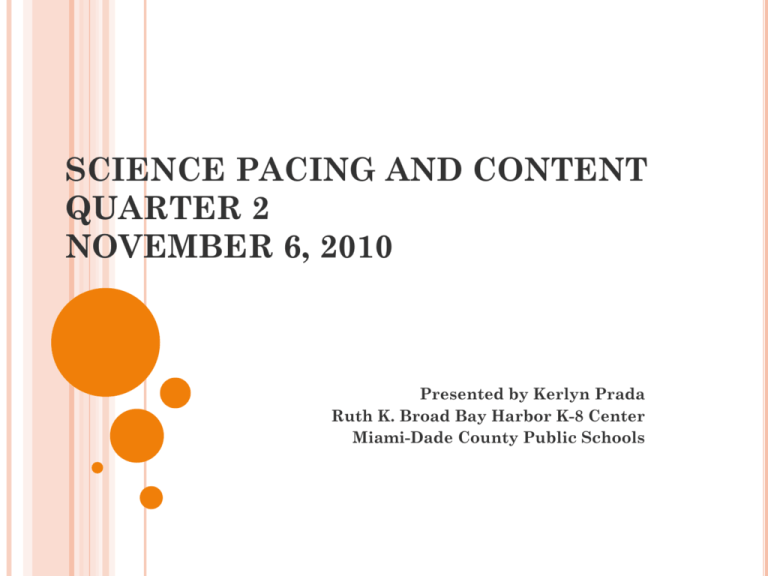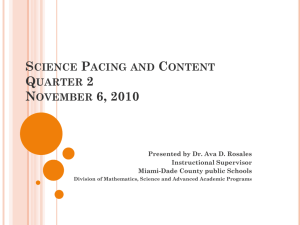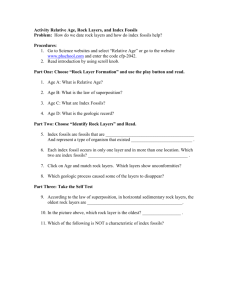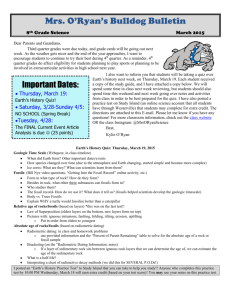TOPIC I: Scientific Method and Theory vs. Law - Science
advertisement

SCIENCE PACING AND CONTENT QUARTER 2 NOVEMBER 6, 2010 Presented by Kerlyn Prada Ruth K. Broad Bay Harbor K-8 Center Miami-Dade County Public Schools ESSENTIAL QUESTION Am I seated at the station that aligns with my curriculum? How do I know? WELCOME Make a Name Tent and include: NAME SCHOOL After reviewing student work from your last lesson, how did you feel and why? AGENDA Goals of the Inservice Review of Pacing and Content Workshops Making Sense of Science Instruction: Rotation Labs. Effective Implementation of the 2010 Pacing Guides Resources and Web Sites GOALS FOR THE SESSION Effective Implementation of the 2010 Pacing Guides with an emphasis in hands-on/minds-on learning ◦ Enhance instructional practices using an “explicit-reflective” approach ◦ Incorporate secondary benchmarks as identified by data analysis ◦ NORMS Participate Actively Ask questions Learn by doing Set your own learning into action _______________________________ Bathroom and Electronic Devices SCIENCE PACING AND CONTENT Q1 - 2 A Review YEAR-AT-A-GLANCE MIAMI-DADE COUNTY PULIC SCHOOLS DISTRICT PACING GUIDE YEAR-AT-A-GLANCE COURSE CODE: 200401001 M/J COMPREHENSIVE SCIENCE 1 ST 1 I. A. Ozone Layer B. Layers of the Atmosphere C. Earth Systems III. Causes of Weather Spheres of the Earth Water Cycle Weather Influences on Local Weather Instruments/tools used to Measure Weather IV. Climate and Global Patterns A. Climate B. Land vs. Water C. Greenhouse Effect D. Global Warming V. VI. Energy Transfer Measuring Heat Protecting from Radiation Modeling the Greenhouse Effect II. Atmosphere and Spheres of Earth A. B. C. D. E. 2 Nine Weeks Thermal Energy Movement A. B. C. D. nd Natural Disasters and their Effects on Floridians A. Hurricanes B. Other Natural Disasters C. Models D. Emergency Preparedness VII. Landforms of the Geosphere A. Types and Formation B. Landforms and Importance to the Environment and Society VIII. Forms of Energy A. Potential Energy B. Kinetic Energy C. Examples of Each Energy IX. 3 Nine Weeks Nine Weeks How Weathering and Erosion Affect the Earth A. Weathering B. Erosion C. Deposition Energy Transfers and the Law of Conservation of Energy A. Law of Conservation of Energy B. Transferring Energy in a System 4th Nine Weeks rd X. Motion of Objects A. Measuring Speed and Distance B. Constructing Line Graphs C. Factors Affecting Speed XI. Types of Forces A. Contact Forces B. Non-Contact Forces XII. Law of Gravity A. Gravitational Force B. Calculating Gravity C. Newton’s Law of Universal Gravitation XIII. Forces and Motion A. Direction of Motion B. Forces XIV. Levels of Organization A. Hierarchical Organization of Organisms B. Linnaean Classification System XV. Cell Theory A. Cell Theory XVI. Cell Structure and Organelles A. Structure of Cells B. Plant and Animal Cell Comparison XVII. A. B. C. D. Human Body Systems Major Body Systems Interactions for Homeostasis The Body Effects of Drugs XVIII. A. B. C. Homeostasis Energy Extraction from Food Removal of Waste Reproducing XIX. Pathogens Comparison A. Viruses B. Bacteria C. Fungi and Parasites D. Disease Prevention XX. Social and Emotional Growth A. Social and Emotional Growth B. Child Abuse and Sexual Abuse UNWRAPPING THE BENCHMARKS WHAT?...WHY?...HOW?... EXPLORING THE PACING GUIDES COMPREHENSIVE SCIENCE 1 TOPICS V THROUGH VII Group Activity: What are the priority activities for each topic? What are the specific instructional strategies? How can “depth of knowledge” be achieved for each topic? TOPIC V: EARTH/SPACE AND NATURE OF SCIENCE LAB ROLES Materials Manager (MM) The materials manager is responsible for obtaining all necessary materials and/or equipment for the lab. Safety Director (SD) The safety director is responsible for enforcing all safety rules and conducting the lab. Roles and responsibilities: Roles and responsibilities: The only person allowed to be out of their seat to Assists the PD with keeping the group on-task pick up needed materials Conducts lab procedures Organizes materials and/or equipment in the work Reports any accident to the teacher space Keeps track of time Facilitates the use of materials during the investigation Assists with conducting lab procedures Assists the MM as needed. Returns all materials at the end of the lab to the designated area Technical Manager (TM) Project Director (PD) The technical manager is in charge of recording all data. The project director is responsible for the group. Roles and responsibilities: Reads directions to the group Keeps group on task Is the only group member allowed to talk to the teacher Shares summary of group work and results with the class Roles and responsibilities: Records data in tables and/or graphs Completes conclusions and final summaries Assists with conducting the lab procedures Assists with the clean up Technical Manager (TM) Project Director (PD) The technical manager is in charge of recording all data. The project director is responsible for the group. Roles and responsibilities: Reads directions to the group Keeps group on task Is the only group member allowed to talk to the teacher Shares summary of group work and results with the class Roles and responsibilities: Records data in tables and/or graphs Completes conclusions and final summaries Assists with conducting the lab procedures Assists with the clean up PRACTICING QUESTIONING Helping students work together to make sense of mathematics or science: "What do others think about what [name] said?" "Do you agree? Disagree?" "Does anyone have the same answer but a different way to explain it?" "Can you convince the rest of us that makes sense?“ Helping students to rely more on themselves to determine whether something is correct: "Why do you think that?" "Why is that true?" "How did you reach that conclusion?" "Can you make a model to show that?" MODELING A LESSON THREE HOLE BOTTLE AND TORNADO MOVEMENTS Engage: Investigations and Scientific Knowledge EXPLICIT INSTRUCTION Nature of Science: Scientific knowledge may change as new evidence is discovered or new scientific interpretations are formed There are multiple methods used in various scientific investigations Earth Systems and Patterns* Assess atmospheric conditions and resulting weather: i.e., hurricanes, tornados, lightning, fronts, and precipitation *Note: SC.6.E.7.4 is annually assessed in grade 8 and only taught in grade 6 WHAT ARE THE PRIORITY ACTIVITIES?...WHICH ONES DID YOU COMPLETE? Topic 1: Processes of Science Labs: Three Hole Bottle (CPALMS) Addresses: SC.6.N.2.2 (AA) Tornado Movements (EL) ◦ Interpreting Satellite Images (TX) Creating Your Own Weather Station (TX) Addresses: SC.6.E.7.6, SC.6.E.7.7 and SC.6.E.7.4 (review) Gizmo: Hurricane Motion (SC.6.E.7.3 review) JASON Project StormZone Current Events on Weather-related Disasters in Florida and their impact on human life (SC.6.E.7.7) Note: Reinforce SC.6.E.7.4 and “assessed as” benchmarks throughout activities ENHANCING CONTENT KNOWLEDGE Lab Rotations: Model How Erosion Works (Topic VI) ◦ VL – How are Materials from Earth Broken Down (Topic VI) ◦ Summary of Chemical Weathering (Topic VI) ◦ Gizmos – Reading Topographical Maps (Topic VII) ◦ FOSS Landforms Module (Topic VII) ◦ Discussion of Content with Depth of Understanding WHAT ARE THE PRIORITY ACTIVITIES? Topic VI: How Weathering and Erosion Affect the Earth Addresses: SC.6.E.6.1 …Earth’s surface is built up and torn down by physical and chemical weathering, erosion, and deposition Lab Activities ◦ Model How Erosion Works (Topic VI) Technology ◦ ◦ VL – How are Materials from Earth Broken Down Summary of Chemical Weathering WHAT ARE THE PRIORITY ACTIVITIES? TOPIC VII: SC.6.E.6.1 Identify different types of landforms on Earth’s surface … (note: landforms in Florida and those found outside Florida) assessed as SC.7.E.6.2 Lab Create a landform modeling lab Technology Gizmo: Reading Topographical Maps FOSS Landforms Module Earthquakes and Volcanoes(VL) YEAR-AT-A-GLANCE MIAMI-DADE COUNTY PUBLIC SCHOOLS DISTRICT PACING GUIDE YEAR-AT-A-GLANCE COURSE CODE: 200207001 M/J COMPREHENSIVE SCIENCE 2 1ST Nine Weeks 2nd Nine Weeks 3rd Nine Weeks I. Heat Energy A. Heat and Temperature B. Properties of Matter C. States of Matter D. Changes of Matter V. Layers of Earth A. Crust B. Mantle C. Core D. Structural Zones IX. Fossils A. Formation of Fossils B. Index Fossils C. Evidence of Species Change II. Conservation of Energy and Energy Transformations A. Law of Conservation of Energy VI. Changes in Earths Surfaces A. Rock Cycle B. Scientific Theory of Plate Tectonics C. Tectonic Plate Movement D. Surface Features X. III. Properties of Waves A. Electromagnetic vs. Mechanical B. Electromagnetic Spectrum C. Scientific Investigations VII. Rock Cycle A. Types of Rocks B. Formation of Rocks IV. Properties of Light A. Light Properties B. Wave Speed in Different Materials VIII. Age of Earth/ Geological Time A. Law of Superposition B. Absolute Age C. Geologic Time Environmental Factors and Evolution A. Scientific Theory of Evolution B. Natural Selection C. Limiting Factors D. Limiting Factors Affecting the Everglades XI. Human Impact on Earth A. Resources B. Biodiversity C. Land D. Air E. Water XII. Evidence of Species Change A. Evidence of Scientific Theory of Evolution B. Adaptations/Natural Selection C. Extinction XIII. Relationships in Ecosystems A. Relationships B. Food Web C. Energy Flow in Ecosystems 4th Nine Weeks XIV. Reproduction A. Asexual-Mitosis B. Sexual-Meiosis C. Effect on Natural Selection D. Human Growth and Reproduction XV. Heredity A. DNA /RNA B. Replication C. Chromosomes XVI. Genetic Traits A. Mendelian Genetics B. Genotype/Phenotype C. Punnett Squares and Pedigrees XVII. A. B. C. D. Biotechnology Cloning Genetic Engineering Artificial Selection Impact on Society XVIII. Health and Disease Prevention A. Human Growth and Development B. HIV/AIDS C. Abstinence D. Mental and Emotional Health EXPLORING THE PACING GUIDES TOPICS III THROUGH IV Group Activity: What are the priority activities for each topic? What are the specific instructional strategies? How can “depth of knowledge” be achieved for each topic? TOPIC V: EARTH/SPACE AND NATURE OF SCIENCE EXPLICIT INSTRUCTION Nature of Science: Distinguish between an experiment and other forms of investigations Experiments have test variables (independent variables) and outcome variables (dependent variables) Forms of Energy* Illustrate the sun’s energy Identify, compare and contrast the variety of types of radiation present in radiation from the Sun Identify and compare characteristics of the electromagnetic spectrum *Note: SC.7.P.10.1 is annually assessed in grade 8 and foundational in grade 7. WHAT ARE THE PRIORITY ACTIVITIES? Topic III: Properties of Waves Technology Electromagnetic Spectrum Gizmo: Longitudinal Waves Labs: Colored Shadows Exploration Making Waves & The Wave Factory (also has activity for SC.7.E.6.1 ENHANCING CONTENT KNOWLEDGE Lab Rotations: Gizmo - Refraction (IV) EL – Solar Energy vs Color (IV) EL – Wave Speed (IV) EL - Density Driven Fluid Flow (V) Modeling the Layers of the Earth with Density Column (V) EL - Density of Rocks (V) Discussion of Content with Depth of Understanding WHAT ARE THE PRIORITY ACTIVITIES? Topic IV: Properties of Light SC.7.P.10.2 …Light can be reflected, refracted, and/or absorbed Lab Activity: EL – Solar Energy vs Color (IV) Technology: Gizmo - Refraction (IV) SC.7.P.10.3…light waves, sound waves, and other waves move at different speeds in different materials Lab Activity: Light Travels Through Objects WHAT ARE THE PRIORITY ACTIVITIES? TOPIC V: SC.7.E.6.1 Describe the layers of solid Earth,…lithosphere, mantle, liquid and solid cores Lab Modeling the Layers of the Earth with Density Column EL - Density Driven Fluid Flow (V) EL - Density of Rocks (V) NAME TENT INCLUDE: NAME, SCHOOL AND WHAT IMAGES COME TO MIND Source: Discovery Science YEAR-AT-A-GLANCE MIAMI-DADE COUNTY PUBLIC SCHOOLS DISTRICT PACING GUIDE YEAR-AT-A-GLANCE M/J COMPREHENSIVE SCIENCE 3 ST 1 I. Nine Weeks Scientific Method and Theory vs Law A. The Nature of Science B. Variables II. Data Collection and Analysis A. Feeding Relationships B. Measurement C. Variables D. Graphing E. Technology III. Science Safety and Ethics A. Ethics B. Laboratory Safety IV. Properties of Matter A. Properties of Matter B. Energy V. Atomic Structure A. Review Atomic Structure VI. Periodic Table A. Revisit Periodic Table of Elements VII. Chemical Bonding A. Chemical Bonding VIII. Energy Transfer and Temperature A. Energy IX. Waves, Circuits, and Energy Resources A. Revisit Properties of Waves B. Visible Light C. Revisit Electrical Circuits D. Energy Resources COURSE CODE: 200210001 nd Nine Weeks 3 Nine Weeks 4th Nine Weeks Speed, Velocity, and Acceleration A. Force and Motion B. Calculations Newton’s Laws of Motion A. Newton’s Laws B. Momentum C. Forces Opposing Motion Plate Tectonics A. Processes that Shape the Earth Weathering and Erosion A. Processes that Shape the Earth Solar System – Earth, Moon, and Sun A. Solar system B. Introduction to Genetics and Diversity Solar System, Earth, Moon, and Sun A. Stars and Galaxies B. Life Cycles of Stars C. Big Bang Theory XVI. Cells to Body Systems A. Revisit Cells B. Revisit Body Systems XVII. Mitosis, Meiosis, and Reproduction A. Meiosis and Mitosis B. DNA C. Chromosomes D. Reproduction E. Fission, Budding, and Regeneration XVIII. Genetics A. Genetics B. Punnett Square C. Genetic Advancements XIX. Adaptation and Variation A. Adaptation and Variation XX. Cycles A. Cycles in Nature B. Energy Transfers in Nature C. Revisit Essential Science Content XXI. The Environment A. The Environment XXII. Pollution A. Pollution Pathways B. Major Sources of Pollution C. Oceanography D. Alternative Energy Resources XXIII. Human Growth and Development – Decision Making A. Decision Making and Problem Solving B. Substance Abuse Prevention XXIV. Human Regulation and Reproduction A. Endocrine System B. Reproductive System C. Human Life Stages D. Planning for Marriage and Parenthood E. Abstinence XXV. Human Growth and Development – Diseases A. Sexually Transmitted Disease B. HIV/AIDS C. Child Abuse 2 X. XI. XII. XIII. XIV. XV. rd EXPLORING THE PACING GUIDES TOPICS VIII THROUGH XI Group Activity: What are the priority activities for each topic? What are the specific instructional strategies? How can “depth of knowledge” be achieved for each topic? EXPLICIT INSTRUCTION Nature of Science: Experiments have manipulated variables (independent variables) and responding variables (dependent variables) A change in one or more variables may alter the outcome of an investigation Forms of Energy Identify kinetic and potential energy in their mechanical, thermal, chemical, electrical, electromagnetic, and nuclear forms Identify standard ways to measure and compare forms of energy Energy conversions Sources of energy: solar, hydroelectric, geothermal, fossil fuels, etc. Electric circuits WHAT ARE THE PRIORITY ACTIVITIES? Topic VIII: Energy Transfer and Temperature Technology Gizmo: Energy Conversion in a System Gizmo: Longitudinal Waves Labs: Solar Cooker Making Waves & The Wave Factory (also has activity for SC.7.E.6.1 BREAK WHOLE GROUP LAB ACTIVITY Plate Tectonics Snickers Lab (VI) TOPIC Unwrap the Benchmark using: Pacing Guide, Item Specifications, Appendix B Conduct Investigation Discuss Implications Benefits Constraints Modifications FOSSILS AND THE LAW OF SUPERPOSITION Liz LaRosa 5th Grade Science http://www.middleschoolscience.com 2009 This PPT was created with the information from the FOSREC Activity “Who’s on First?” and “Fossil Inferences” by UEN. FOSSILS AND SUPERPOSITION What is a fossil? The trace or remains of an organism that lived long ago, most commonly preserved in sedimentary rock What is a superposition? Younger rocks lie above older rocks if the layers have not been disturbed RELATIVE DATING AND INDEX FOSSILS What is relative dating? ◦ Any method of determining whether an event or object is older or younger than other events or objects. What is an index fossil? A fossil that is found in the rock layers of only one geologic age and is used to establish the age of the rock layers. ◦ Is found in rock layers around the world, ex Trilobites ◦ ACTIVITY # 1 On your desk, you have 8 large colored index cards with nonsense letters placed on them. Your task is to determine what the correct sequence of the letters are. You have two clues: 1. 2. The card with the letters “C” and “T” is on the bottom, or the oldest layer Look for a card that has either a “T” or “C” written on it for the second layer This is one possible way to arrange the cards. Questions: MD 1.What letter is the oldest? 2.What letter is the youngest? DXO 3.What letter showed up the most? 4.Which letters only showed up once? ON 5.Which letters could be index fossils? 6.How did you know which was older: “M” NB or “X”? NBU UA AGC CT ACTIVITY # 2 Flip your eight index cards over Arrange the index cards that represent layers of rock and fossils Clues: 1. 2. 3. The oldest layer has the letter “M” in it Find a rock layer that has at least one of the fossils you found in the oldest rock layer Extinction is forever - once an organism disappears from the sequence it cannot reappear later Teacher Note: I replaced the letters with nonsense letters b/c spelling the word “organism” was too easy for my 5th graders TO THINK ABOUT… What problems did you run into when trying to arrange the fossils into the correct sequence? Would this have been more difficult if you did not know which layer was the oldest to start the activity? Which organism is the most complex of all the fossils and why? ROTATION LABS Density-Driven Fluid Flow (V) Crayon Rock Cycle (VII) M&M Radioactive Decay (VIII) Fossil Formation – JASON Science (IX) EXPLICIT INSTRUCTION TOPIC V, VII Identify and/or describe the layers of Earth Describe the Scientific Theory of Plate Tectonics Describe how the movement of Earth’s crustal plates and the flow of heat and material cause various geologic events to occur Describe density differences between layers of Earth Identify causes of volcano formation EXPLICIT INSTRUCTION FOR TOPICS VI Identify and/or describe steps of the rock cycle and relate them to surface and sub-surface events. EXPLICIT INSTRUCTION FOR TOPIC VIII Identify examples of and/or explain physical evidence that supports scientific theories that Earth has evolved over geologic time due to natural processes. Idenetify and/or describe current scientific methods for measuring the age of Earth and its parts. Understand use of fossil records Folding and faulting as related to the Law of Superposition Understand, conceptually, radioactive dating LAB WRITE-UP FORMATS Writing in Science – tapping into student thoughts Selecting the appropriate format Modeling Framework – demonstrations, models Power Writing and the Art of Scientific Conclusions Parts of a Lab Report Engineering design RESOURCES Curriculum and Instruction http://curriculum.dadeschools.net/ Instructional Technology (Examview Item Bank) http://it.dadeschools.net Florida Department of Education http://www.fldoe.org/ FCAT Resources - http://fcat.fldoe.org/ Florida Standards and Course Descriptions http://www.floridastandards.org/ Florida PROMiSE http://flpromise.org/ Gizmos http://www.explorelearning.com SCIENCE WEB SITE: HTTP://SCIENCE.DADESCHOOLS.NET DISCOVERY SCIENCE Direct links to instructional tools in Pacing Guides no login required Access through Teacher Portal – then open Pacing Guide JASON PROJECT SCIENCE WWW.JASON.ORG THE SCIENCE CLASSROOM ESSENTIALS Contact information: Kerlyn Prada kprada@dadeschools.net REFLECTIONS AND FOLLOW-UP Follow-up Due: FOLLOW-UP Based on Data Analysis of prior knowledge items on First Nine Weeks Resource Test, identify which secondary benchmarks need to be addressed and when Use Year-at-a-Glance, Appendix B and Item Specifications to assist







